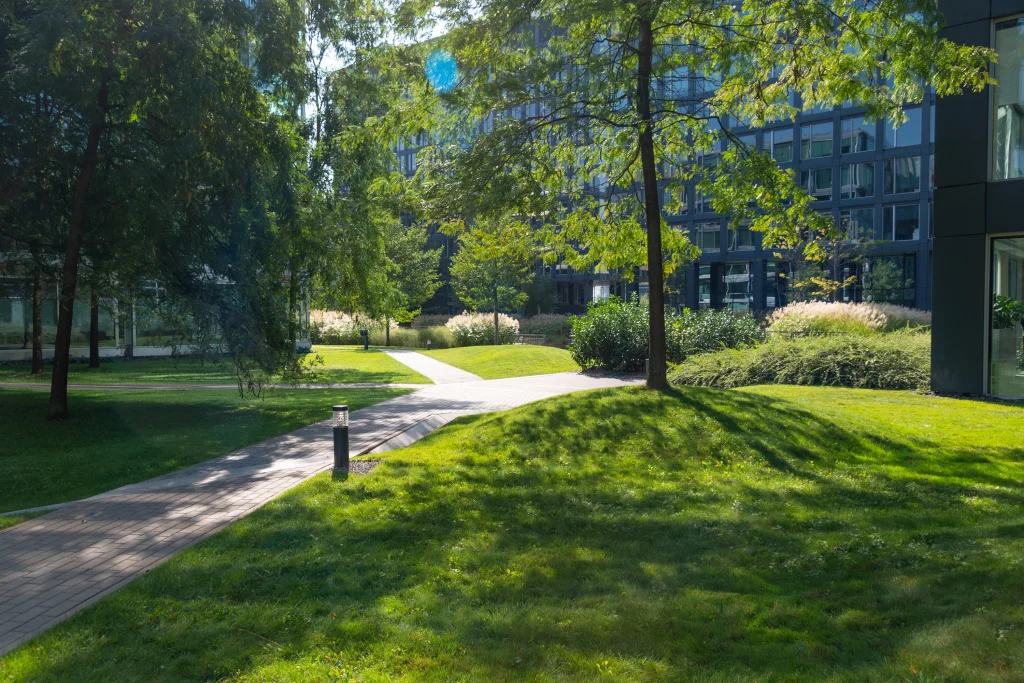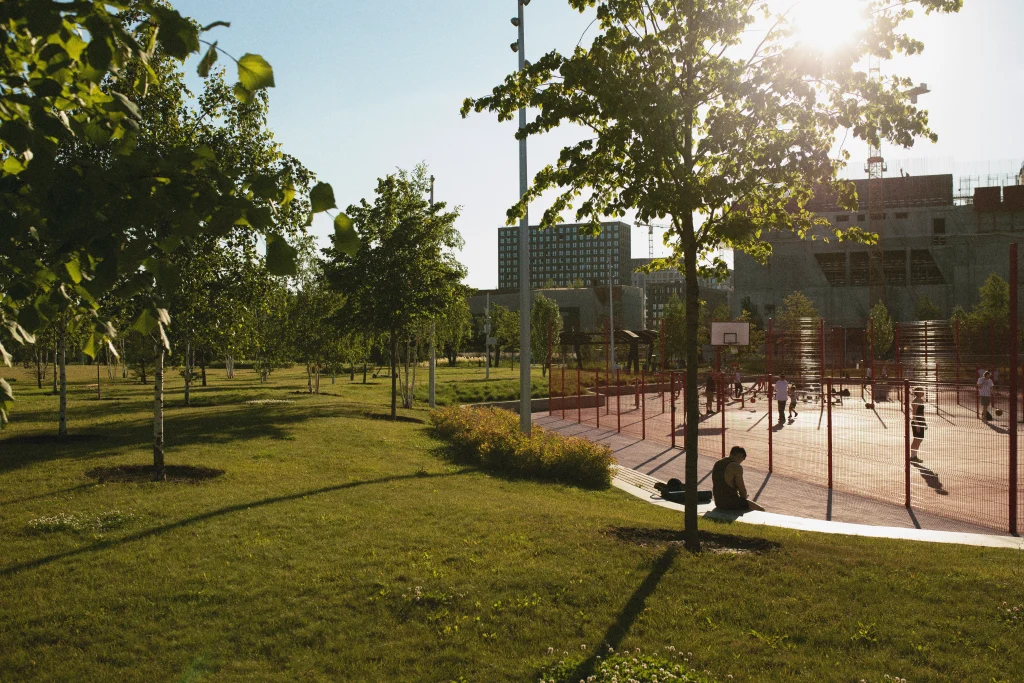What’s the Problem?
Look around at most office buildings, schools, or shopping centers. What do you see? Probably tons of concrete parking lots, some grass that nobody ever uses, and a few decorative plants that need constant watering. Building managers often see outdoor spaces as just something they have to maintain, not as something useful.
This old-school approach creates real problems:
- Wasting water: Traditional landscapes use 50% more water than eco-friendly options. With water bills rising 5-8% each year in many areas, that’s a lot of money in the dirt.
- High maintenance costs: All that mowing, fertilizing, and upkeep for regular grass areas requires about 70% more work hours than sustainable designs.
- Creating heat islands: Concrete and asphalt absorb heat and make surrounding areas 15-20°F hotter. For every 1°F temperature increase, air conditioning systems use about 2% more energy.
- Causing flooding issues: Concrete doesn’t absorb water, creating up to 16 times more runoff than planted areas. Many cities now charge fees for properties that create excess runoff.
Effective stormwater management is a critical aspect of broader facility resilience. To learn more about preparing for various disruptions, read about Emergency Planning: What It Is and Why It Is Crucial.
- Missed opportunities: Unused outdoor spaces are wasted real estate that could be helping the building and the people who use it.
The Better Alternative: Smart Green Spaces
Smart green spaces aren’t just about making things look pretty—they’re strategic designs that solve multiple problems at once.
Here’s how they help:
Money-Saving Benefits
- Lower water bills: Native plants and smart irrigation systems use 50-80% less water. For a medium-sized commercial building, that’s $8,000-15,000 saved every year.
- Reduced maintenance: Natural landscapes need 40-75% less maintenance than traditional grass. That means $3,000-7,000 saved per acre each year.
- Energy savings: Strategically placed trees can cut cooling costs by 15-35% during summer. For a typical commercial building, that’s $5,000-12,000 saved annually.

For more comprehensive strategies on optimizing your building’s energy consumption, explore our guide on Energy Efficient Strategies for Facilities.
- Higher property values: Buildings with quality landscapes can charge 7% higher rent and see 14% higher retail sales compared to buildings with minimal landscaping.
- Longer-lasting pavement: Shade from trees can extend the life of asphalt by 40-60% by reducing heat damage, saving thousands in replacement costs.
Benefits for People
- Productivity boost: Research shows that seeing green spaces improves brain function by 16% and reduces mental fatigue. For someone making $80,000 a year, that 16% improvement is worth almost $13,000.
- Fewer sick days: Buildings with quality green spaces report 19% fewer absences. For a company with 100 employees making around $80,000 each, that’s about $190,000 in recovered productivity annually.
- Happier tenants: Buildings with accessible green spaces have 23% higher tenant satisfaction and 7% higher retention rates, significantly reducing turnover costs.
- Health benefits: Regular exposure to green space is linked with 18-23% lower stress levels and related health care costs.
Before vs. After: The Transformation
Imagine transforming your facility or workplace:
- Unused grass areas become vibrant gardens with native plants that attract butterflies and birds
- Concrete areas are replaced with permeable pavers that prevent puddles after rain
- Strategic shade trees reduce building temperature and create comfortable outdoor study or meeting spaces
- Rain gardens capture stormwater while creating beautiful landscape features
When businesses make these changes, they see real results:
| What We Measure | Before | After | Benefit |
| Annual water cost | $12,000-18,000 | $2,400-7,200 | $9,600-10,800 savings |
| Maintenance hours | 35 hours/acre/month | 12 hours/acre/month | 23 hours/acre/month reduction |
| Cooling energy | Baseline | 15-25% reduction | $5,000-12,000 annual savings |
| Stormwater fees | $8,000-15,000 annually | $2,000-6,000 annually | $6,000-9,000 savings |
| Student/Employee satisfaction | Baseline | 23% improvement | Better recruitment/retention |
| Property value | Baseline | 7-10% increase | Significant value boost |
Smart green spaces aren’t just good for the environment—they’re a smart investment that saves money, improves health, and creates spaces people desire to use.
From Concept to Reality: Guide to Implementing Green Spaces
Step 1: Check Out What You’re Working With
Before jumping in, take a good look at what you already have:
- Make a list of what’s there: Document the paved areas, plants, sprinkler systems, and any outdoor spaces people use.
- Look at the bills: Check 1-2 years of water bills and maintenance costs to see what you’re spending.
- Watch how people use the space: Do people truly use the outdoor areas? If not, why?
- Check the environment: Where does the sun hit hardest? Which way does the wind usually blow? Where does water collect when it rains?
- Spot opportunities: Identify the areas that would make the biggest impact if changed.
Step 2: Plan Based on Your Building Type
Different buildings need different approaches:
Office Buildings
- Focus on creating spaces where employees can work or meet outside
- Make entrance areas green and inviting
- Add WiFi to outdoor spaces
- Use attractive rain gardens that also manage stormwater
Industrial Properties
- Choose low-maintenance plants that still perform well
- Focus on reducing heat and managing rainwater
- Use plants as natural screens to block unsightly areas or reduce noise
- Create nice break areas for employees
Schools and Campuses
- Balance improved appearance with practicality
- Create outdoor classrooms or demonstration gardens
- Include plants that look interesting in all seasons
- Design spaces that engage the school community
Step 3: Design It Right
No matter what kind of building you have, follow these basic principles:
- Choose the right plants: Use native plants that naturally grow in your area and don’t need much special care. Group plants with similar water needs together.
- Take care of your soil: Healthy soil means healthy plants. Add compost to improve soil quality and try not to disturb the soil too much.
- Be smart with water: Install irrigation systems that check soil moisture and weather forecasts. Use drip irrigation where possible—it’s 90% more efficient than sprinklers.
- Use materials that let water through: Replace unnecessary concrete with permeable materials that let rainwater soak into the ground.
- Create zones with a purpose: Design each area for a specific use (like gathering, walking, or just looking nice) instead of generic “landscaped areas.”
Step 4: Maintain It Properly
Sustainable landscapes need different, not necessarily more, maintenance:
- Control pests smartly: Watch for problems and use natural solutions before reaching for chemicals.
- Feed plants naturally: Use compost tea and organic materials instead of chemical fertilizers.
- Water only when needed: Program irrigation based on what plants really need, not on a fixed schedule.
- Adapt as you go: Regularly check how things are doing and make adjustments rather than following rigid maintenance plans.
- Track your success: Monitor water use, maintenance hours, and how well the landscape is performing to show it’s worth the investment.
Overcoming Common Challenges
“We don’t have enough money.”
- Start small with high-visibility areas that show quick results
- Use money from your maintenance budget since you’ll save on upkeep
- Look for rebates from your water company or energy provider
- Many cities offer reduced fees for properties that manage their own rainwater
Real Example: An office complex in Denver cut its landscape renovation budget by 35% by spreading the work over 3 years. The money they saved on maintenance from the first phase helped pay for later phases.
“We don’t have enough space.”
- Go vertical with green walls on buildings or free-standing structures
- Use movable planters for flexibility
- Replace unnecessary pavement with plants
- Look at rooftops as potential green spaces
Expert Tip: “Even buildings with limited space can go green,” says sustainable landscape architect Susan Martinez. “A series of container plants can provide many of the same benefits as in-ground landscapes while being more flexible.“
“Maintenance will be too complicated.”
- Train your maintenance staff in sustainable practices
- Focus contracts on results, not activities
- Use smart irrigation and monitoring systems
- Design plant communities that work together and need less intervention
Money Saver: Maintenance contracts that focus on performance typically cost 15-30% less than conventional “mow, blow, and go” services while giving better results.
“People won’t support the change.”
- Show how green spaces solve multiple problems at once
- Start with small demonstration projects and document the before/after
- Get key people involved in the design process
- Use established standards like SITES or LEED to give your project credibility.
Strategy Tip: “Document your starting point thoroughly before beginning any project,” advises Sustainable Facilities Manager Michael Thompson. “Nothing builds support like clear before/after comparisons with real numbers.“

The Future Is Smart
Cool New Technology
- AI-powered irrigation systems that automatically adjust based on weather and soil moisture
- Robot mowers that reduce labor and run on renewable energy
- Sensor networks that detect plant problems before they’re visible
- Technology that accurately measures how much carbon your landscape captures
Integration with Building Systems
- Coordinating irrigation with HVAC systems to enhance cooling efficiency
- Connecting landscape water needs with building water recycling systems
- Using trees and plants strategically to reduce building energy use
- Including landscape performance in building management dashboards
Preparing for Climate Change
- Using diverse plant communities that better survive extreme weather
- Creating systems that capture rainwater for use during dry periods
- Designing landscapes that moderate temperature extremes
- Creating flexible outdoor spaces that can adapt to changing needs
“Smart landscapes integrated with smart buildings are the next big thing,” says Dr. Elena Roberts, Director of Sustainable Development at the Urban Land Institute. “Organizations that embrace this approach will gain major advantages in efficiency, user experience, and environmental performance.”
Your Action Plan
Do This Now (Next 30 Days)
- Record your current landscape water use, maintenance costs, and how people use the space.
- Identify priority areas for potential transformation
- Figure out who the key decision-makers are for landscape changes
- Gather local case studies, rebate information, and qualified service providers
Short-Term Steps (1-6 Months)
- Select a visible area for your first project
- Set specific, measurable goals for landscape performance
- Create a comprehensive plan for implementation
- Make sure maintenance providers understand sustainable practices
Long-Term Strategy (6-24 Months)
- Implement changes in phases based on priority and budget
- Track resource use, maintenance requirements, and user feedback
- Refine maintenance based on what you observe
- Share your successes and lessons learned with stakeholders
Conclusion: Why This Matters
Treating outdoor spaces as just decorative is a major missed opportunity. Smart green spaces deliver real value in multiple ways: they use fewer resources, cost less to maintain, create better experiences for people, and improve environmental performance.
As buildings face pressure to be more efficient and sustainable, smart landscaping offers a powerful strategy that’s often overlooked. By transforming underused outdoor spaces into high-performing sustainable landscapes, forward-thinking managers can tackle multiple challenges while creating environments that reflect their values and increase property value.
The most successful buildings in the coming years will be those that recognize landscapes aren’t just for looks—they’re essential components of high-performing properties that deliver significant returns on investment.
The time to create smart green spaces isn’t sometime in the future—it’s now. Others are already making this change.
Are you ready to transform your outdoor spaces from maintenance burdens into valuable assets?
Connect with Left Coast Facilities Consulting, the experts in sustainability for facilities and facility management, and let’s unlock your facility’s full potential.



